Anda mungkin bisa menggunakan berbagai cara untuk mengisi daya smartphone, misalnya menghubungkan ke komputer, stop kontak, atau mungkin ke powerbank. Namun, bagaimana jika disekitar Anda tidak ada stop kontak dan powerbank Anda mati?
Nah, ada seorang mahasiswi berusia 18 tahun, bernama Ann Makosinski, yang bisa mengatasi hal tersebut. Dia menciptakan gelas yang bisa mengisi baterai ponsel Anda. Tak perlu disambungkan dengan listrik terlebih dahulu, gelas bernama eDrink ini menggunakan panas yang dihasilkan oleh minuman panas untuk mengisi daya ponsel.
Anda hanya perlu menyambungkan ponsel dengan gelas menggunakan kabel USB, kemudian mengisi gelas tersebut dengan minuman panas. Gelas tersebut langsung akan bereaksi dan mengisi daya smartphone saat itu juga. Sangat canggih bukan?
Gadis cantik ini bukan pertama kalinya menciptakan barang keren yang berbeda dari yang lain seperti gelas ini. Ketika berusia 15 tahun, Ann mengembangkan sebuah senter yang bisa digunakan menggunakan panas tubuh manusia. Ya, idenya adalah menggunakan panas sebagai sumber listrik.
Menurut Ann Makosinski, gelas ini bisa memecahkan dua masalah sekaligus, kopi yang terlalu panas untuk diminum dan ponsel yang daya baterainya habis terlalu cepat. Berkat penemuannya, remaja ini mendapatkan 50.000 dollar dari sebuah perusahaan untuk proyeknya berikutnya.
sebenernya konsep ini bisa disebut dengan termoelektrik,lalu
Apakah termoelektrik itu?
Teknologi termoelektrik adalah teknologi yang bekerja dengan mengkonversi energi panas menjadi listrik secara langsung (generator termoelektrik), atau sebaliknya, dari listrik menghasilkan dingin (pendingin termoelektrik). Untuk menghasilkan listrik, material termoelektrik cukup diletakkan sedemikian rupa dalam rangkaian yang menghubungkan sumber panas dan dingin. Dari rangkaian itu akan dihasilkan sejumlah listrik sesuai dengan jenis bahan yang dipakai.
Prinsip kerja dari termoelektrik adalah dengan berdasarkan Efek Seebeck yaitu “jika 2 buah logam yang berbeda disambungkan salah satu ujungnya, kemudian diberikan suhu yang berbeda pada sambungan, maka terjadi perbedaan tegangan pada ujung yang satu dengan ujung yang lain” ( Muhaimin, 1993).
Untuk keperluan pembangkitan lisrik tersebut umumnya bahan yang digunakan adalah bahan semikonduktor. Semikonduktor adalah bahan yang mampu menghantarkan arus listrik namun tidak sempurna. Semikonduktor yang digunakan adalah semikonduktor tipe n dan tipe p. Bahan semikonduktor yang digunakan adalah bahan semikonduktor ekstrinsik. Terdapat tiga sifat bahan termoelektrik yang penting, yaitu :
1. Koefisien Seebeck (s)
2. Konduktifitas panas (k)
3. Resistivitas (ρ)
Sejarah penemuan energi termoelektrik
Fenomena termoelektrik pertama kali ditemukan tahun 1821 oleh ilmuwan Jerman, Thomas Johann Seebeck. Ia menghubungkan tembaga dan besi dalam sebuah rangkaian. Di antara kedua logam tersebut lalu diletakkan jarum kompas. Ketika sisi logam tersebut dipanaskan, jarum kompas ternyata bergerak. Belakangan diketahui, hal ini terjadi karena aliran listrik yang terjadi pada logam menimbulkan medan magnet. Medan magnet inilah yang menggerakkan jarum kompas. Fenomena tersebut kemudian dikenal dengan efek Seebeck.
Penemuan Seebeck ini memberikan inspirasi pada Jean Charles Peltier untuk melihat kebalikan dari fenomena tersebut. Dia mengalirkan listrik pada dua buah logam yang direkatkan dalam sebuah rangkaian. Ketika arus listrik dialirkan, terjadi penyerapan panas pada sambungan kedua logam tersebut dan pelepasan panas pada sambungan yang lainnya. Pelepasan dan penyerapan panas ini saling berbalik begitu arah arus dibalik. Penemuan yang terjadi pada tahun 1934 ini kemudian dikenal dengan efek Peltier. Efek Seebeck dan Peltier inilah yang kemudian menjadi dasar pengembangan teknologi termoelektrik.
Pengembangan energi termoelektrik
Sejak awal tahun 1990, tuntutan dunia tentang teknologi yang ramah lingkungan sangat besar. Ini memberikan imbas kepada teknologi termoelektrik sebagai sumber energi alternatif. Banyak aplikasi lain penggunaan energi termoelektrik selain pada RTG yang digunakan oleh Voyager 1.
Salah satunya adalah penerapan teknologi termoelektrik pada pembangkitan listrik dari sumber panas. Sampai saat ini pembangkitan listrik dari sumber panas harus melalui beberapa tahap proses. Bahan bakar fosil akan menghasilkan putaran turbin apabila dibakar dengan tekanan yang sangat tinggi. Hasil putaran turbin tersebut akan dipakai untuk memproduksi tenaga listrik. Efisiensi energi pembangkit ini masih rendah akibat beberapa kali proses konversi. Panas yang dihasilkan banyak yang dilepas atau terbuang percuma. Dapat digunakan suatu metode yang dikenal sebagai cogeneration di mana panas yang dihasilkan selama proses dapat digunakan untuk tujuan alternatif. Dengan menggunakan termoelekrik, panas yang dihasilkan selama proses diubah menjadi listrik, sehingga panas yang dihasilkan tidak terbuang secara percuma dan energi yang dihasilkan oleh pembangkit menjadi lebih besar, serta efisiensi energi menjadi lebih tinggi.
Contoh penerapan lainnya yang sedang dikembangkan saat ini adalah pemanfaatan perbedaan panas di dasar laut dan darat, sistem hybrid pada kendaraan bermotor yang memanfaatkan motor listrik dan mesin pembakaran, serta pemanfaatan pada pembangkit listrik tenaga surya.
Kesulitan terbesar dalam pengembangan energi ini adalah mencari material termoelektrik yang memiliki efisiensi konversi energi yang tinggi. Parameter material termoelektrik dilihat dari besar figure of merit suatu material. Idealnya, material termoelektrik memiliki konduktivitas listrik tinggi dan konduktivitas panas yang rendah. Namun kenyataannya sangat sulit mendapatkan material seperti ini, karena umumnya jika konduktivitas listrik suatu material tinggi, konduktivitas panasnya pun akan tinggi.
Walaupun demikian, teknologi material yang saat ini sedang berkembang pesat terutama kemampuan menyusun material dalam level nano diharapkan dapat menghasilkan suatu material termoelektrik dengan efisiensi yang tinggi.
Alat dan Bahan dalam rangka pembuatan termoelektrik generator
1. Bor
2. Sumber panas (Api Spirtus)
3. Thermal pasta
4. Perkakas
5. Peltier 4 buah, sebagai bahan utama pembuatan Thermoelectric generator
6. Heatsink kecil (heatsink panas), fungsinya untuk menyerap panas
7. Heatsink besar (heatsink dingin), fungsinya untuk membuang panas
Cara Membuat Thermoelectric Generator
1. Lubangi heatsink menggunakan Bor
2. Berikan thermal pasta ke heatsink
3. Letakan peltier ke heatsink yang sudah diberi pasta
4. Pasang heatsink panas, sehingga peltier diapit oleh 2 buah heatsink
5. Pasang baut pengunci
6.
Sambungkan kabel keempat peltier secara seri, jika di rangkai seri maka
tegangan bertambah namun arus tetap. Jika pararel, tegangan tetap namun
arus bertambah.
7. Thermoelectric Generator siap digunakan
Untuk
membuktikan alat ini, sudah dibuat papan kontrol untuk generator ini
untuk menghidupkan Led 12V, Fan DC 12V, Speaker USB, Charger HP 12V.
Output dari generator ini rata-rata 8V, sehingga diperlukan rangkaian penaik tegangan dan disetting di 12V.
Output dari generator ini rata-rata 8V, sehingga diperlukan rangkaian penaik tegangan dan disetting di 12V.
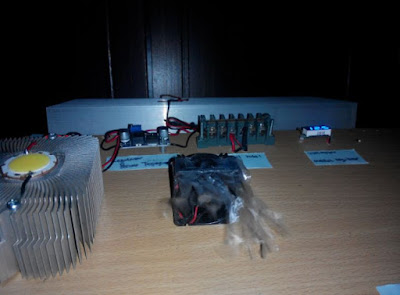 |
| Fan DC 12V HIGH RPM |
You may be able to use a variety of ways to charge your smartphone, for example, connecting to a computer, plugs, or perhaps to POWERBANK. However, what if in your life there is no outlet and POWERBANK you die?Well, there is a 18-year-old student, named Ann Makosinski, which can overcome it. He created a glass that could charge your phone battery. No need to be connected to electricity first, named eDrink glass using heat generated by a hot beverage to charge the phone.You just need to connect the phone to the glass using a USB cable, and then fill the glass with hot drinks. The glasses will react immediately and charge the smartphone immediately. Highly sophisticated instead?
Do thermoelectric it?Thermoelectric technology is a technology that works by converting heat energy directly into electricity (thermoelectric generator), or otherwise, of the electricity generating cold (thermoelectric coolers). To generate electricity, the thermoelectric material is quite laid in such a way in a circuit that connects a source of heat and cold. The series will be produced from a number of electricity in accordance with the type of materials used.The working principle of thermoelectric is on the basis that Seebeck Effect "if two different metal pieces attached to one end, then given a different temperature at the connection, then there is a difference voltage at one end to the other end" (Iskandar, 1993).
For the purposes of electricity generation is generally the materials used are semiconductor materials. Semiconductors are materials capable of delivering an electric current, but not perfect. Semiconductors used are n-type semiconductors and p-type. Semiconductor material used is extrinsic semiconductor materials. There are three important properties of thermoelectric materials, namely:1. The Seebeck coefficient (s)2. The thermal conductivity (k)3. Resistivity (ρ)
History of the discovery of thermoelectric energyThermoelectric phenomenon was first discovered in 1821 by a German scientist, Thomas Johann Seebeck. He connects copper and iron in a circuit. In between the two metals are then placed a compass needle. When the metal is heated, it turns the compass needle moved. Later known, this happens because the flow of electricity that occurs in metals generate a magnetic field. This magnetic field that moves a compass needle. The phenomenon became known as the Seebeck effect.Seebeck's discovery inspired the Jean Charles Peltier to see the reverse of the phenomenon. She electric discharge on two metal pieces are glued in a circuit. When electric current is applied, heat absorption occurs at the junction of the two metals and the release of heat on the other connection. The release and absorption of this heat turned to each other so the current direction is reversed. The discovery occurred in 1934 was later known as the Peltier effect. Seebeck and Peltier effect is then the basis for the development of thermoelectric technology.Thermoelectric energy developmentSince the beginning of 1990, the demands of the world of environmentally friendly technologies is very large. It delivers electrical current to the thermoelectric technology as an alternative energy source. Many other applications of thermoelectric energy use in addition to the RTG used by Voyager 1.One is the application of thermoelectric technology in power generation from thermal sources. Until now the generation of electricity from the heat source must go through several stages of the process. Fossil fuels will produce a turbine wheel when burned with a very high pressure. The turbine round results will be used to produce electricity. The energy efficiency of these plants is low due to the number of times the conversion process. Heat generated much is removed or wasted. Can be used a method known as cogeneration where the heat generated during the process can be used for alternative purposes. By using termoelekrik, the heat generated during the process is converted into electricity, so that the heat produced is not wasted in vain and the energy produced by the plant becomes larger, as well as energy efficiency becomes higher.Examples of other applications that are being developed today is the use of heat differences in seabed and land, hybrid systems in motor vehicles utilizing electric motors and the combustion engine, as well as the utilization of solar power plants.The biggest difficulty in the development of this energy is to find a thermoelectric material that has a high energy conversion efficiency. Thermoelectric material parameters seen from the figure of merit of a material. Ideally, the thermoelectric material has a high electrical conductivity and low thermal conductivity. But the reality is very difficult to get material like this, because generally if a material of high electrical conductivity, thermal conductivity will be high.However, materials technology which is currently growing rapidly, especially ability to arrange the material in nano level expected to produce a thermoelectric material with high efficiency.
Tools and materials in order to manufacture thermoelectric generator
1. Drill
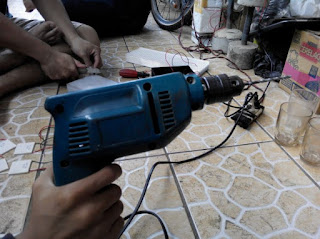
2. The heat source (Fire methylated)
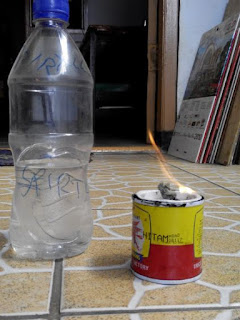 3. Thermal paste
3. Thermal paste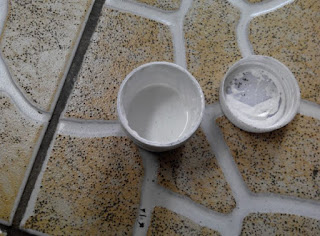 4. Tools
4. Tools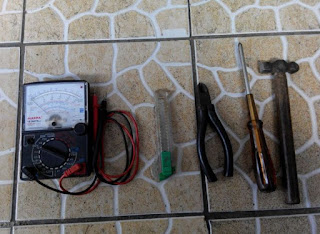 5. Peltier 4 pieces, as the main ingredient manufacture of thermoelectric generators
5. Peltier 4 pieces, as the main ingredient manufacture of thermoelectric generators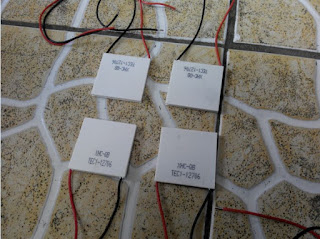 6. small heatsink (heatsink hot), functions to absorb heat
6. small heatsink (heatsink hot), functions to absorb heat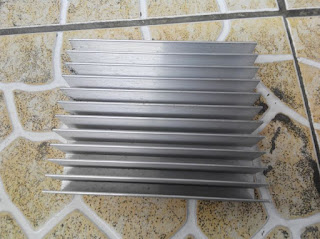 7. The large heatsink (heatsink cooler), function is to remove heat
7. The large heatsink (heatsink cooler), function is to remove heat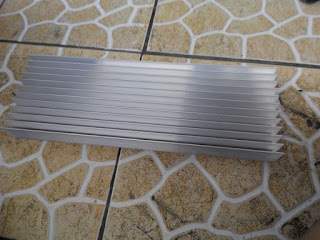 How to Make Thermoelectric Generator
How to Make Thermoelectric Generator1. Punch a hole heatsink using Bor
 2. Apply thermal paste to the heatsink
2. Apply thermal paste to the heatsink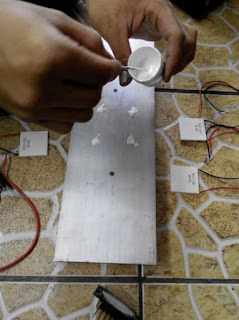 3. Put the peltier heatsink that has given pasta
3. Put the peltier heatsink that has given pasta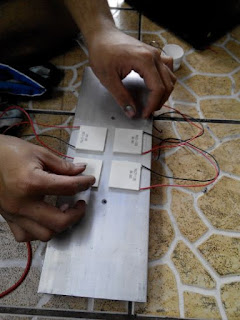
4. Place the hot heatsink, so peltier flanked by two pieces heatsink
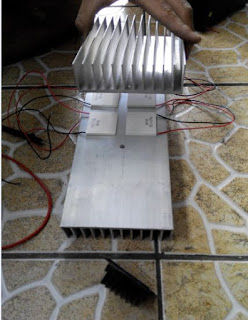
5. Replace the locking bolt
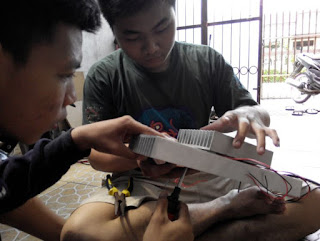 6. Connect the peltier fourth in series, if the chain series, the voltage increases but remains current. If parallel, fixed voltage but current increases.
6. Connect the peltier fourth in series, if the chain series, the voltage increases but remains current. If parallel, fixed voltage but current increases.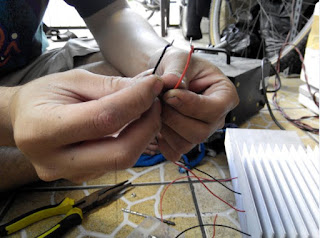 7. Thermoelectric Generator is ready for use
7. Thermoelectric Generator is ready for use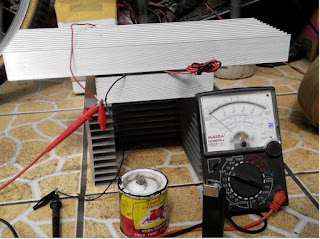 To prove this tool, already made boards for the control of this
generator to turn Led 12V, 12V DC Fan, USB Speaker, Charger HP 12V.The output of this generator average 8V, so that the necessary circuit voltage riser and be set at 12V.
To prove this tool, already made boards for the control of this
generator to turn Led 12V, 12V DC Fan, USB Speaker, Charger HP 12V.The output of this generator average 8V, so that the necessary circuit voltage riser and be set at 12V.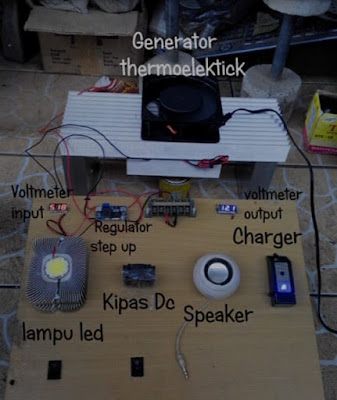
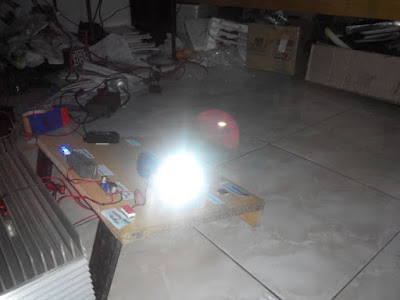 |
| Led menyala terang |
 |
| Fan DC 12V HIGH RPM |

No comments:
Post a Comment